Rare and attractive, birds with red tails are found across the world. Red tails can be seen on some of the species about to be extinct.
In rare cases, they are also seen on highly common birds living in their millions.
From crimson to brown-red, various nuances are specific to various species. They can even play a role in breeding as males with red tails often display themselves to females.
The following species of birds often have red tails both on males and females, often even across their subspecies.
Table of Contents
1. Red-Tailed Hawk
Red-Tailed Hawks (Buteo jamaicensis) are some of the most adaptable birds with red tails also present in North America.
Known for living on the continent and on small islands, this is a species with a brick-red tail, seen across many of its subspecies.
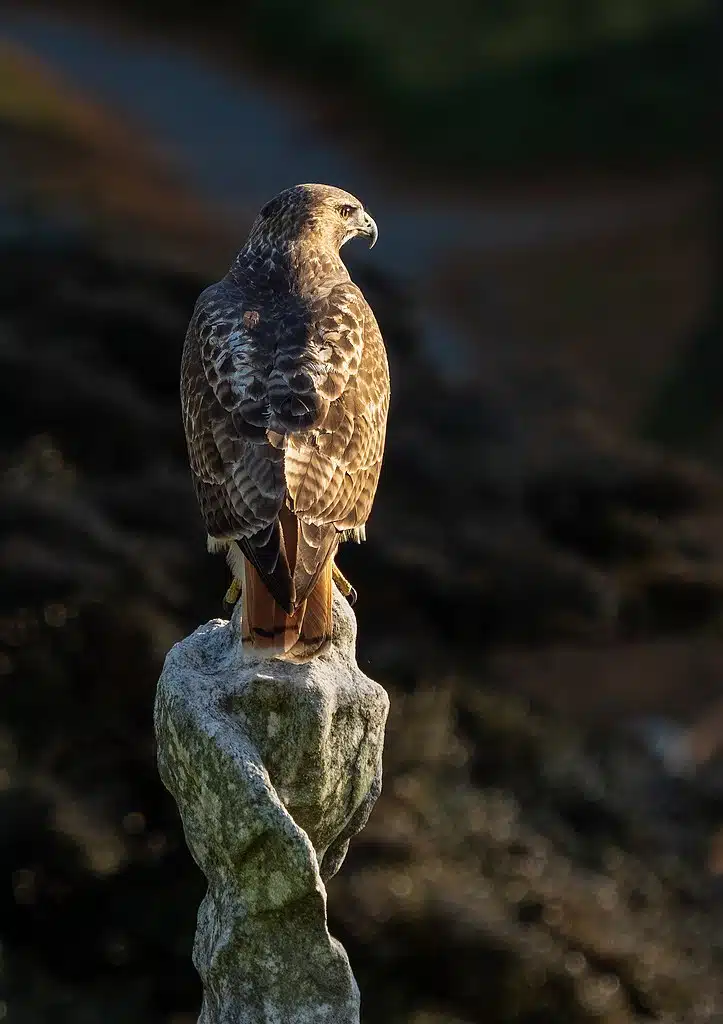
A brown type of hawk, Red-Tailed Hawks have tails that may grow to 10 inches.
These tails can also be orange, black, or brown.
Red-Tail Hawks are found at high vantage points such as on trees where they can look for rodents or other animals to feed on.
Apart from perching, Red-tailed Hawks can also cruise at several feet looking for food.
The cruising altitude of these birds varies, but it’s rarely higher than 100 feet. Their nests are also laid on trees or structures up to 69 feet high.
Red-Tailed Hawks live in areas with other species of hawks and raptors in North America.
Humans can identify them quickly by their red tails and the black first section of their wings.
They share some of their behavioral traits with other hawks, on the other hand. For example, they have a rasping screaming call that resembles those of other species.
2. Red-Tailed Black-Cockatoo
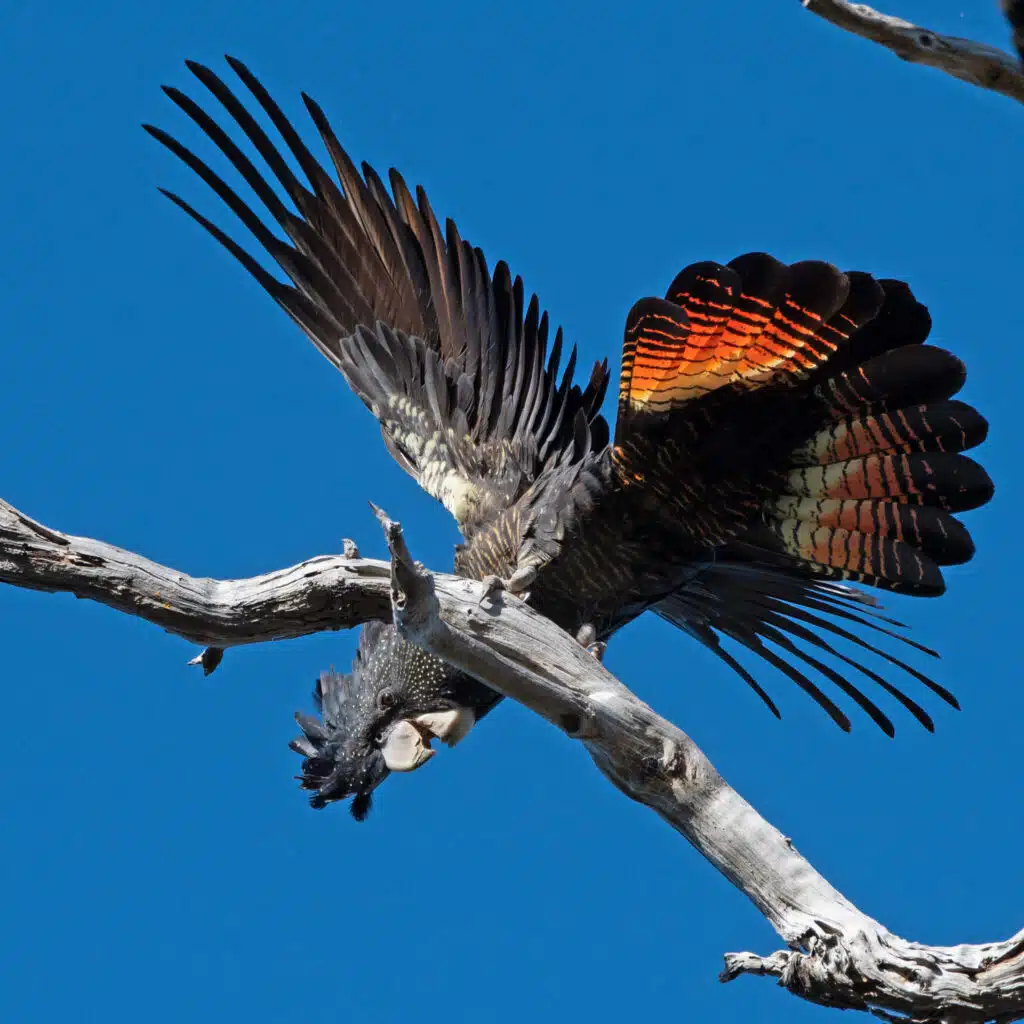
An Australian native, The Red-Tailed Black-Cockatoo (Calyptorhynchus banksii) has wide red tails.
These are only specific to males as females have orange and black tails. Large red sections on the male’s undertail are also coupled with smaller orange panels.
This cockatoo is mostly black and is found across Australia with a notable presence in the Northern territories.
These types of birds are long-lived and may take a few years to reach their adult coloring with either red or orange tails.
It typically takes around 4 years for them to get their final plumage nuance.
It prefers dry habitats and while it can be a spotted red-tailed species in Southern Australia, it’s a notable presence on crops in the North, where it can even act as a pest.
In the wilderness, these cockatoos are seen in flocks. They can form their own flocks or join other species in group living, sometimes in their hundreds.
Due to their slow flying skills, these cockatoos only join other slow-flying species in their flocks which cover short distances at once.
3. Glossy Black Cockatoo
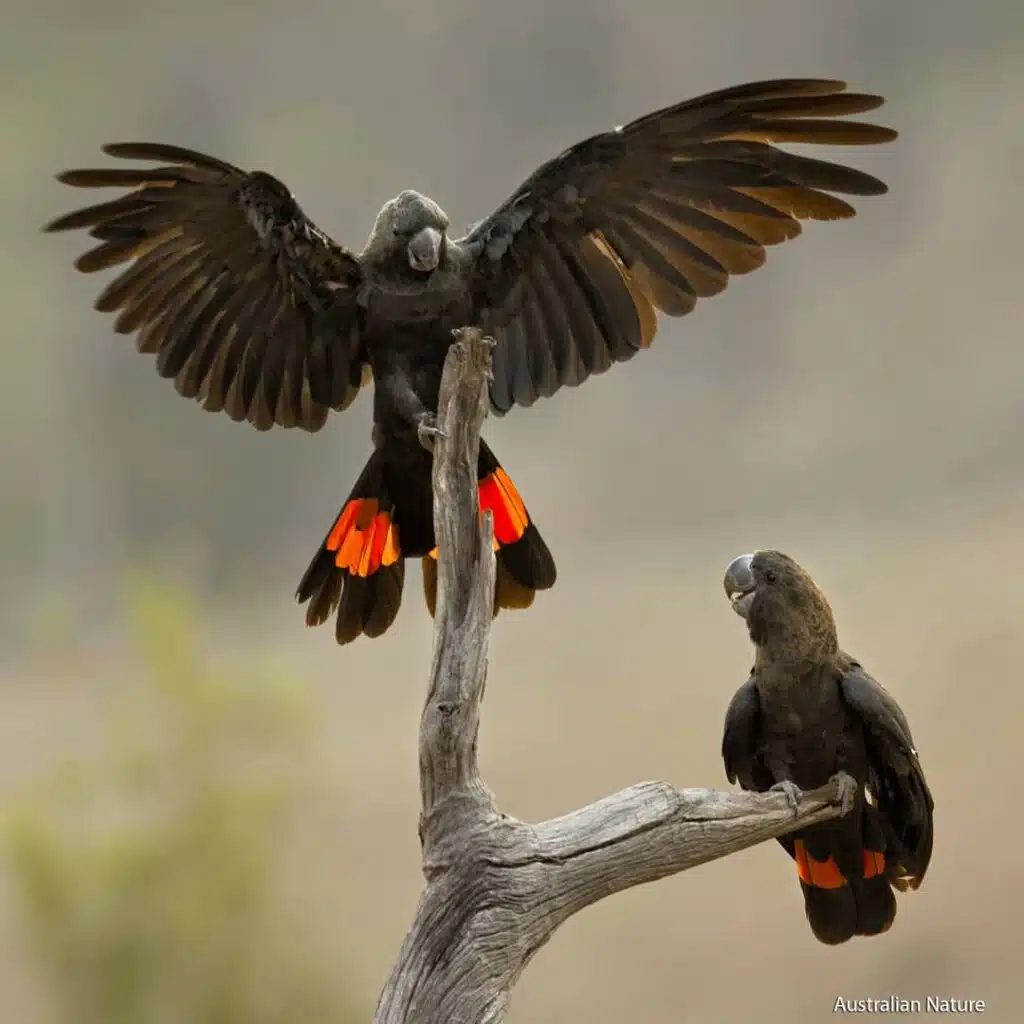
Reaching a size of up to 19 inches, Glossy Black Cockatoos (Calyptorhynchus lathami) are among the largest birds with red tails.
Like other similarly-colored birds of this species, they’re also native to Australia and mostly located on the Eastern side of the country.
Black and brown dominant plumage is specific to male and female cockatoos of the species.
Males are the ones with the red tails and the black overall appearance. Females are brown and also have striped red tails instead of fully-red tails.
These types of cockatoos are believed to be endangered and may only be found in Australia.
In Australia, the birds live in shea-oak forests and are typically active during the day.
4. Red-Tailed Comet
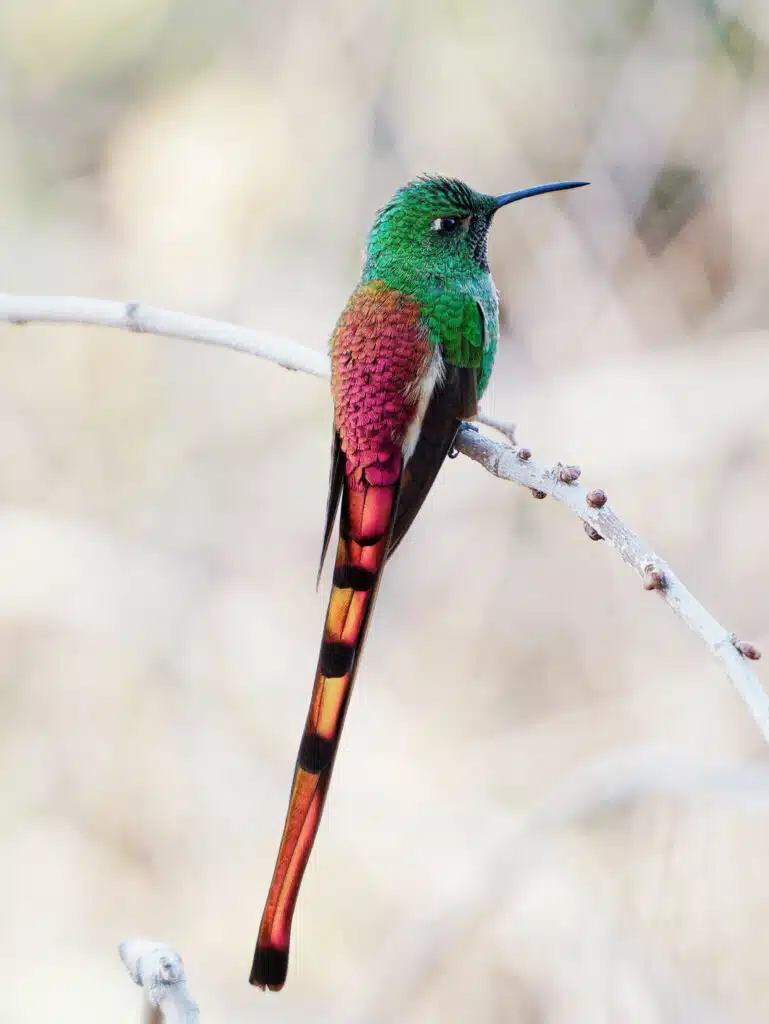
Red-Tailed Comets (Sappho sparganurus) are record-breaking types of birds.
They grow to 8 inches and have spectacular long tails as long as their bodies. These hummingbirds have a split tail, which has red, black, and golden nuances, in the case of males.
Their tails show red bands and red solid sections and are matched by the copper-red nuance of their lower backs.
Male Red-Tailed Comets are further known for having a metallic green head and shoulders, a nuance highly common among other hummingbirds as well.
Males eventually get a golden-red tail with black marks as they age.
With only 2 subspecies, Red-Tailed Comets are among the birds of South America that live in the forests of Argentina and Peru.
5. Red-Tailed Tropicbird
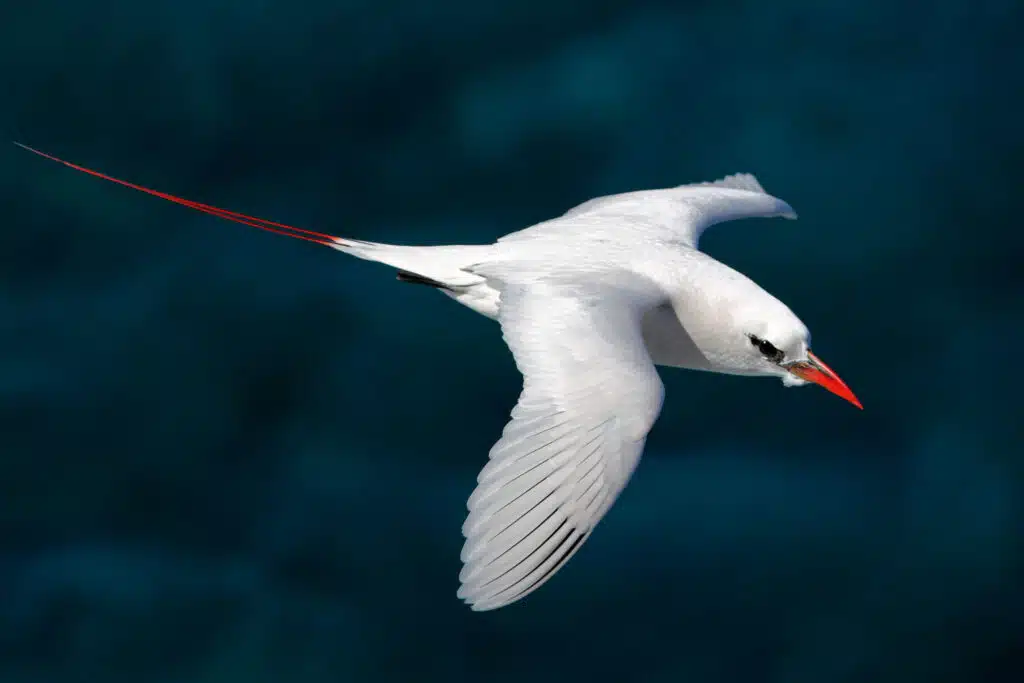
Tropicbirds of this species (Phaethon rubricauda) are natives of the oceans. They live in The Indian and Pacific Oceans often flying long distances for food or breeding.
Long narrow red tails are specific to their tails in a nuance that only matches the vivid red appearance of their beaks.
Their tails can grow to 14 inches as these are large birds where the tail represents around one-third of the total length.
Their plumage is white while there are only dark sections around the eyes.
This is a species that lands on islands in the ocean for breeding and laying eggs.
Female Red-Tailed Tropicbirds lay a single egg. Males and females form long-lasting relationships and take turns in the egg’s incubation period.
Some of the places where these birds with red tails prefer to nest on include open cliff areas but they can build a basic cup-shaped nest on the ground as well.
6. Plumbeous Water Redstart
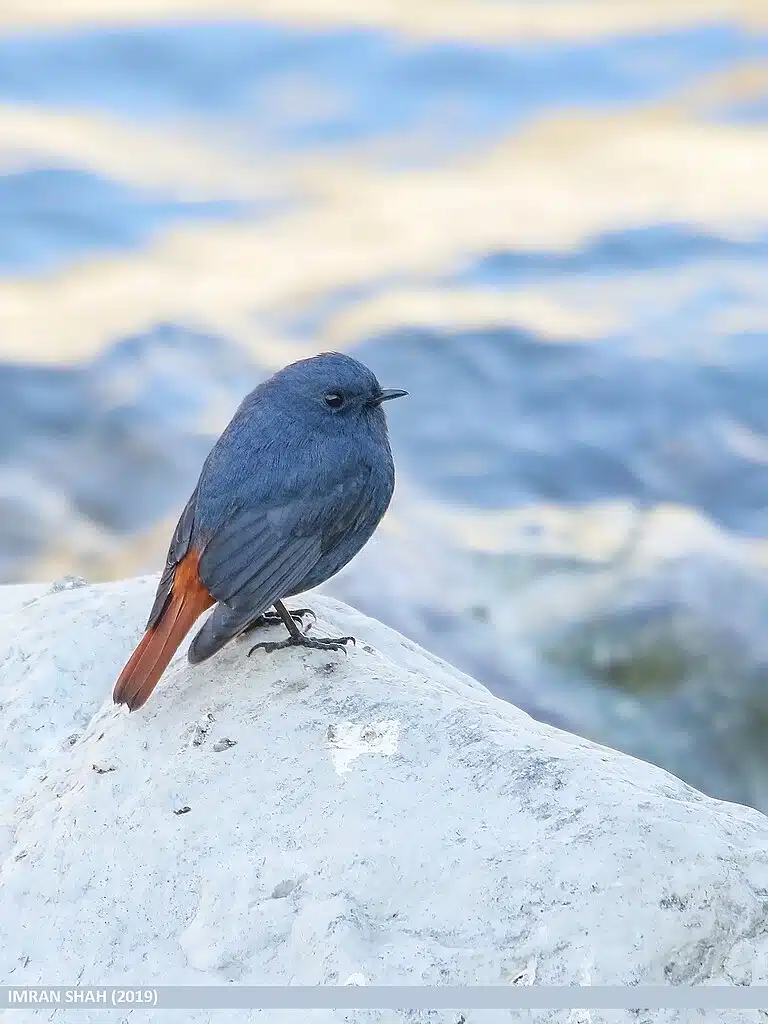
Some birds have metallic colors which inspired their names. Plumbeous Water Redstarts (Phoenicurus fuliginosus) are named after their lead-like color.
This is a type of dark blue nuance that dominates the male’s body and wings, apart from its tail which is red.
There’s a copper-red or brown-red nuance specific to the short tails of the males.
Lead colors are specific to the head, chest, and wings.
Females show dark gray and black tails and are also less colorful than males.
A typical male of the species measures anywhere between 3.5 and 5.5 inches and can be spotted in small groups.
Taiwan, India, and China are just a few countries where these small birds live in.
They are also among the birds of The Himalayas especially since they like living at very high altitudes.
Some of the highest-elevation species even live in areas between 10 and 12.000 feet.
7. Crimson-Rumped Toucanet

A species with a long black beak that shows a white stripe and white colors at the base, The Crimson-Rumped Toucanet (Aulacorhynchus haematopygus) also has partly red tails.
Males and females show crimson patches at the base and at the tip of their long tails.
There are only 2 subspecies of these birds and both can also come in chestnut-red tail nuances.
Bright green plumage dominates the appearance of these toucanets. In some males and females, there’s also a golden or yellow hint along the area of the shoulders.
Crimson-Rumped Toucanets in Ecuador additionally show blue sections at the base of the beak.
A species of large forests, Crimson-Rumped Toucanets are native to the mountains of Western South America.
They even live thousands of feet high, at elevations of up to 9.000 feet where they eat fruit and insects.
8. Red-Tailed Shrike

A bird of Siberia, The Red-Tailed Shrike (Lanius phoenicuroides) is among the species with dark red tails.
This is a species with brown-red tails and brighter caps brown or tan caps.
Earthy nuances are specific to this bird as a means of camouflage and their darker red tails are also less easy to spot compared to crimson tails.
The birds of the species are found in East Asia where they eat insects.
Migration periods are among the best times to see these birds together as they move in mass.
Red-Tailed Shrike are among the birds that lay spotted eggs soon after migrating to their breeding sites. They lay cream eggs with both brown and black spots.
9. Maroon-Bellied Parakeet

The 2 subspecies of The Maroon-Bellied Parakeet (Pyrrhura frontalis) live in the Eastern and Southeastern forests of South America.
From above, their tails are mostly green and yellow-green.
When seen from below, their red details attract the most attention. This is a species with a dark red undertail or a maroon-red undertail with matching belly plumage.
Some red marks are further visible just above the black beak of this species.
Dominated by green nuances, these birds show white sections around the eyes and mostly green wings that feature blue outer areas.
Faint brown spots are seen at the sides of the male’s head. This small and often overlooked physical trait also inspires the local name of the species of The Brown-Eared Conure.
More common in captivity, these birds are appreciated for their ability to talk.
10. Red-Necked Buzzard

Africa’s West Coast is home to the red-tailed Red-Necked Buzzard (Buteo auguralis).
From Mauritania to Angola, this is a species that has a widespread presence in savannahs and next to woodlands.
Living at different elevations, The Red-Necked Buzzard shows various brown nuances and red-brown tails.
Brown spots or red-brown spots are also characteristic of its underside. These types of spots are seen on its underwings as well as on its chest.
The species is a known carnivore and an avid flyer covering long distances for food. Rodents and reptiles are part of its diet.
Birds of this species spend most of their time on trees where they also build their nests above the ground.
11. Red-Tailed Wheatear
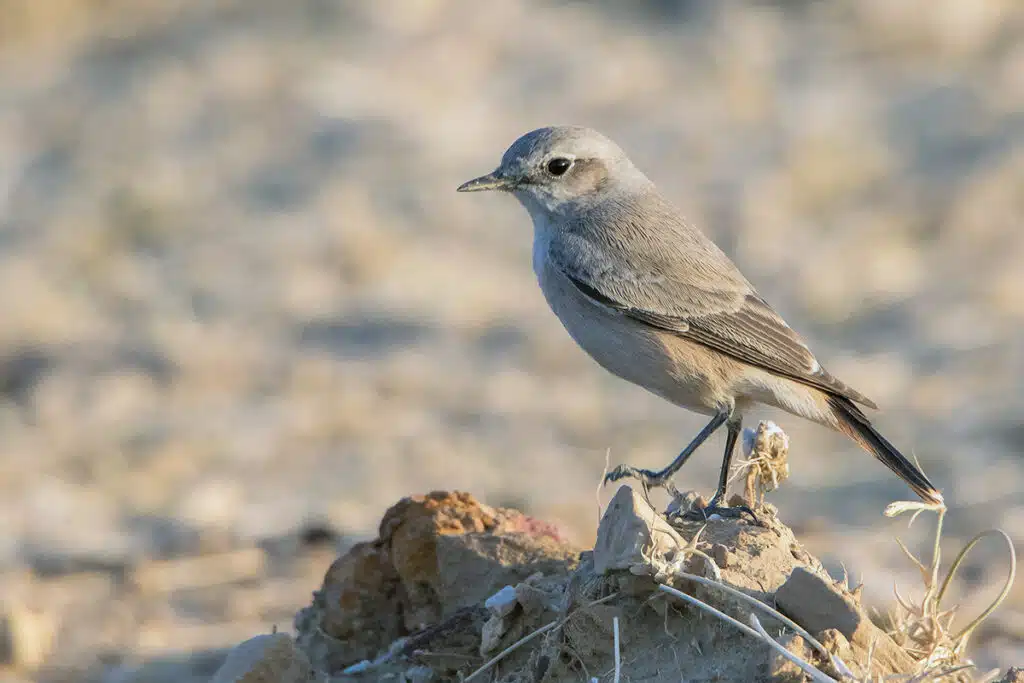
Some birds live in barren areas in the mountains. These are areas of low vegetation but not without food, especially below the surface.
This is the case of The Red-Tailed Wheatear (Oenanthe chrysopygia), a species that specializes in living and feeding in low vegetation areas at an elevation of several thousand feet.
It lives in a vast habitat spreading from Turkey to Pakistan where it spends its life mostly on the ground.
A dull-colored species with a red tail, this is a bird that can eat different types of insects and caterpillars.
Some of its rare adaptations include the capacity to find insects nesting underground.
These birds may also descend to deserts and warmer areas in short-distance wintertime migration.
12. Leaf-Love

Vocal birds with red tails include species such as Leaf-Love birds (Phyllastrephus scandens), apart from the whistling Red-Tailed Wheater.
These birds are found in the rainforest and next to water sources where food is available.
Chestnut-red tails are specific to these birds. Their tails measure up to 3 inches and match the color of the wings in nuance.
The head and underside of the birds are mostly gray.
2 Leaf-Love subspecies are identified in Western and Central Africa. Some of the differences in appearance between these subspecies include the brown nuance of the wings but both have red tails.
There’s a difference in their habitat depending on their region, however. Apart from humid areas of forests, they can also live close to water in the savannah.
13. Fiji Parrotfinch
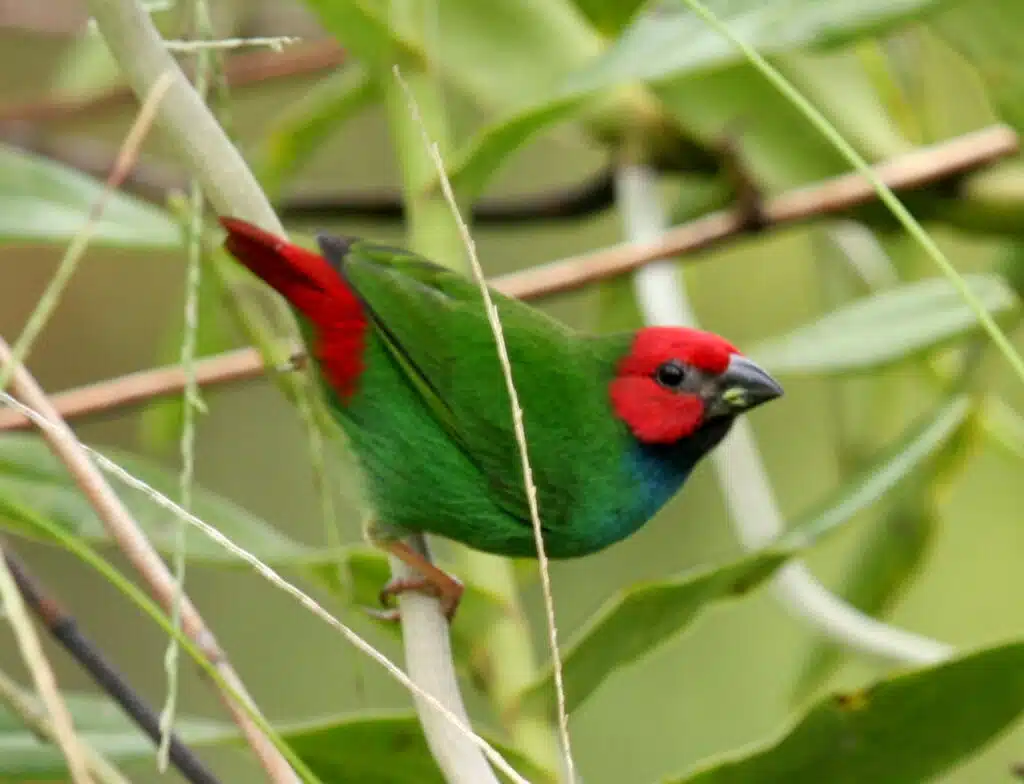
Red tails and red heads are seen on Fiji Parrortfinches (Erythrura pealii). These birds have vivid red tails and matching heads while green dominates their appearance.
The green color itself helps them hide among the grasses and trees they live among.
Fiji Parrotfinches are among the species that also live in suburban and urban areas.
As long as there’s grass such as the ones in parks or on lawns, Fiji Parrotfinches can live in these areas.
The bird is well-known as a result. Its breeding habitats attract a lot of attention.
Males display themselves to females and chase them in flight. Breeding happens up on trees where the female hands upside down.
14. White-Capped Redstart
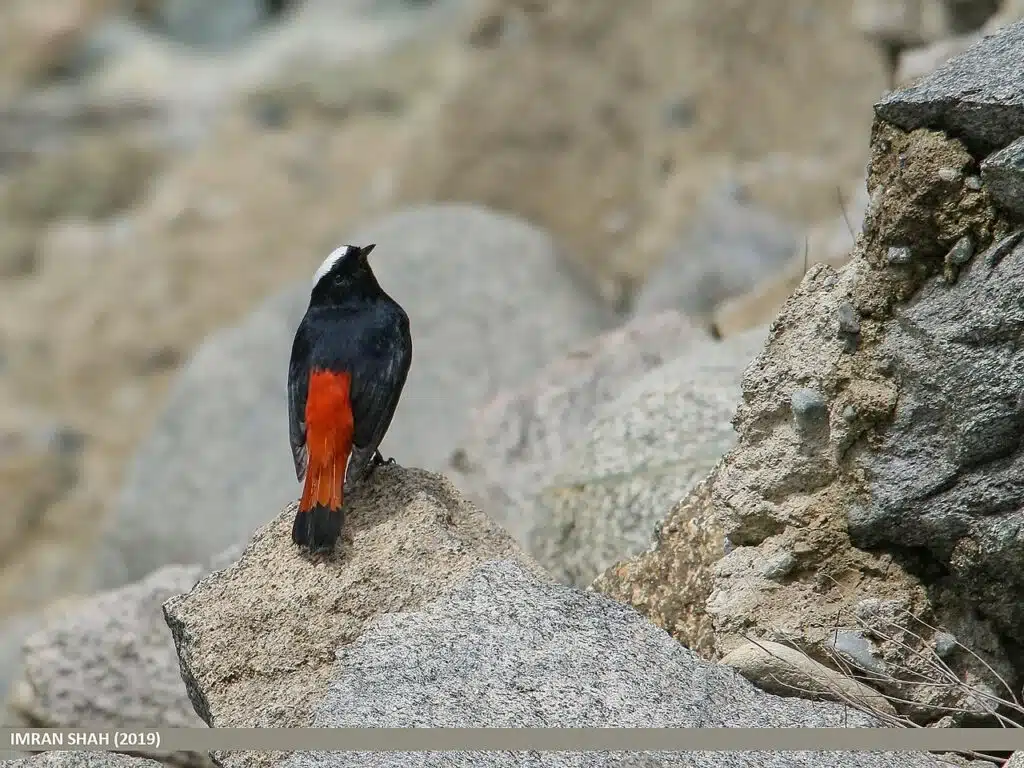
Atypical color patterns are specific to the Asian White-Capped Redstart (Phoenicurus leucocephalus).
This is a small black bird with a short red tail that additionally has a black tip. Similar red nuances are continued on the underbelly and on the lower back.
Black is specific to its upper back, wings, and chest.
A white cap contrasts the dark appearance of this bird further. Native to India, Myanmar, and other nearby countries.
This bird can be seen along streams, in rocky areas where it can make a quick escape if needed.
It can also be heard as White-Capped Redstarts have a high-pitched call.
Feeding habits include eating small insects they can find next to streams as well as on shallow rocky streams.
15. African Grey Parrot
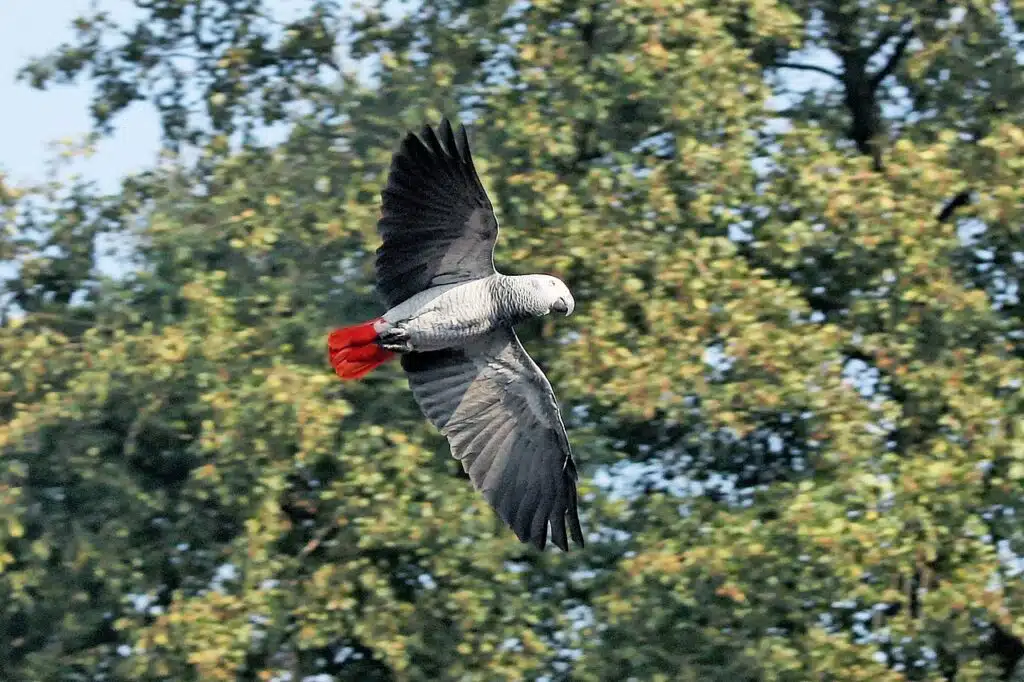
African Grey Parrots (Psittacus erithacus) are found in The Western countries of the continent and in the central sub-Saharan countries of Africa.
This is a species with a bright red undertail that is easy to spot given its dull gray overall appearance.
Apart from their colorful tails, these birds are remarkably bright. Their intelligence has been compared to the intelligence of a young child.
Among the things it can do and recognize, The African Grey Parrot can learn sequences.
Nobody knows the exact numbers of these species across Africa. By some optimistic estimates, the species lives in the wilderness in its millions.
African Grey Parrots are long-lived birds. While they can live almost as long as humans, they tend to live shorter lives in the wilderness.
16. Red-Tailed Minla

6 colors are specific to the multicolored Red-Tailed Minla (Minla ignotincta).
This is a species with a partially red tail which is also black and yellow at the tip. Yellow nuances dominate the appearance of the underbelly with black, white, and mustard colors being specific to the wings of the species.
Brown nuances are further seen at the base of its wings while a striped black and white head is also characteristic of the bird.
A species of The Indian Subcontinent, Red-Tailed Minlas do have some color variation among males and females.
Yellow tail tips can be orange on males while females have extra black areas on their tails.
The Red-Tailed Minla is a rare species with a potentially endangered status. It’s believed only a few thousand birds of this species remain.
17. Red-Tailed Vanga
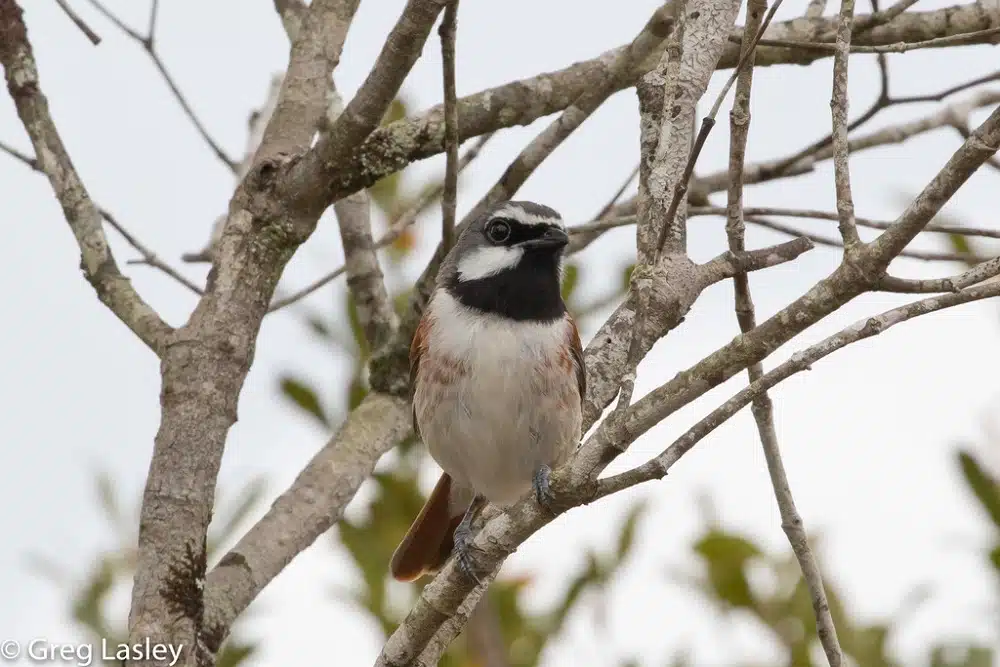
A rare bird endemic to the forests of Madagascar, The Red-Tailed Vanga (Calicalicus madagascariensis) is a species with orange-red tails.
Their tails are long, measuring up to 2 inches.
Red sections are also specific to another part such as the upper back and partly on the wings. The dirty white plumage on the chest also shows red spots in the case of males.
Gray sections dominate the nuances of the wings and of the head, which additionally shows white stripes.
White areas are also seen around the eyes.
Females of the species have brown-red tails and are dominated by brown nuances. They even show bright brown underbellies and gray-brown caps.
Birds of the species are arboreal and mostly found in humid forests where they remain active throughout the year.
18. Red-Tailed Parrot

Green and red parrots aren’t rare but Red-Tailed Parrots (Amazona brasiliensis) are among the green and red parrots about to be extinct.
Only several thousand individuals remain in Southeastern Brazil as these birds live only on the coast where they’re easily captured.
Red undertails are specific to these birds, together with red, blue, and green faces.
Typically found in the coastal regions of Sao Paolo state, these are the areas these birds use for food.
They forage here but lay eggs on small islands off the coast.
Red-Tailed Parrots are rarely seen on their own as they live in flocks. Tens or hundreds of parrots are seen together on the coasts of Southeastern Brazil.
This movement of flocks between the mainland and islands is associated with a beneficial role in the ecosystem. Red-Tailed Parrots are foragers that disperse seeds from the mainland to the islands.
19. Red-Tailed Bristlebill
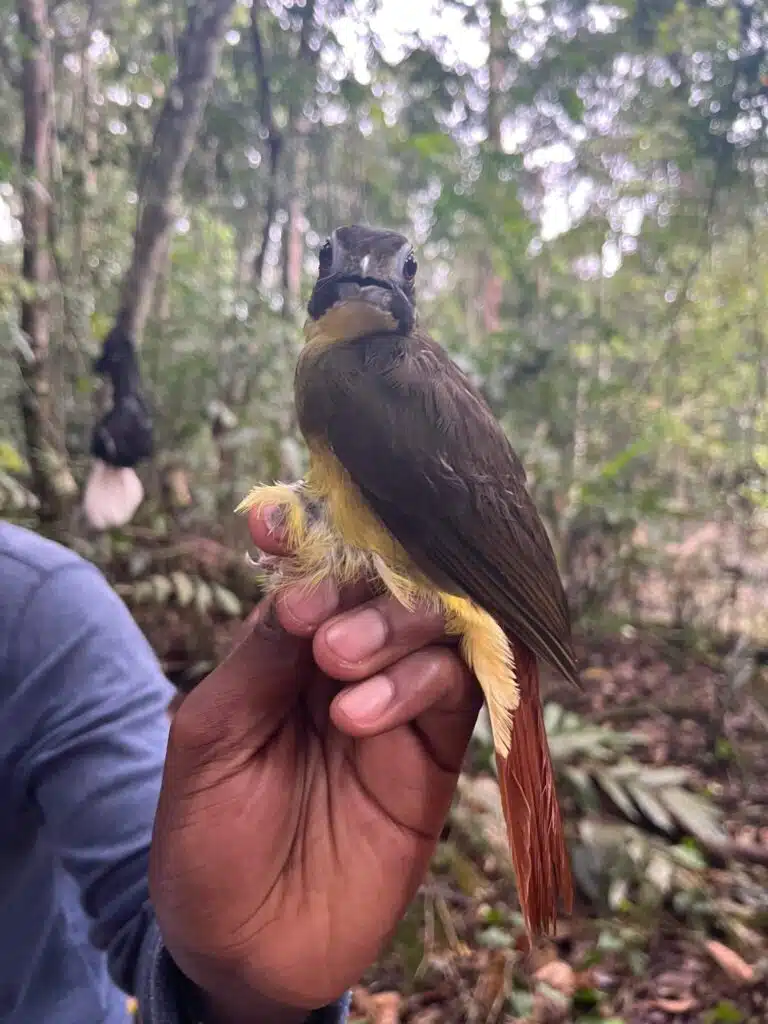
An African native, The Red-Tailed Bristlebill (Bleda syndactylus) is a species found in the Western forests of the continent.
A red-brown tail is seen on the species. Its long tail has a different color to the mostly dark green plumage of the birds which also show yellow necks and underbellies.
Dark green nuances are specific to its dominant plumage while brown-red tails are seen both on males and females.
White or yellow sections are further visible around the eyes.
In the immature stages, Red-Tailed Bristlebills have yellow circles around the eyes.
These red and long-tailed birds also have repetitive low-pitched vocalizations and are typically found in dense forests, under canopy and rarely found in clearing or forest openings.
20. Red-Tailed Laughingthrush

A species of Southeast Asia, Red-Tailed Laughingthrushes (Trochalopteron milnei) have long tails.
Bright red nuances dominate the appearance of their tails with additional black margins.
Vivid red colors are also seen along its wings while its underbelly and shoulders are gray.
Orange to brick-red caps dominates the appearance of its head. White and grey sections are seen on its face while bright blue eye rings complete the patterns of its face.
This species is only found at high elevations, thousands of feet high in countries such as Myanmar, Thailand, and China.
While it lives in high-elevation forests, this is a bird that still finds insects and various bugs to feed on.
It relies almost exclusively on fruit and plants during the cooler months,
21. Red-Tailed Ant-Thrush
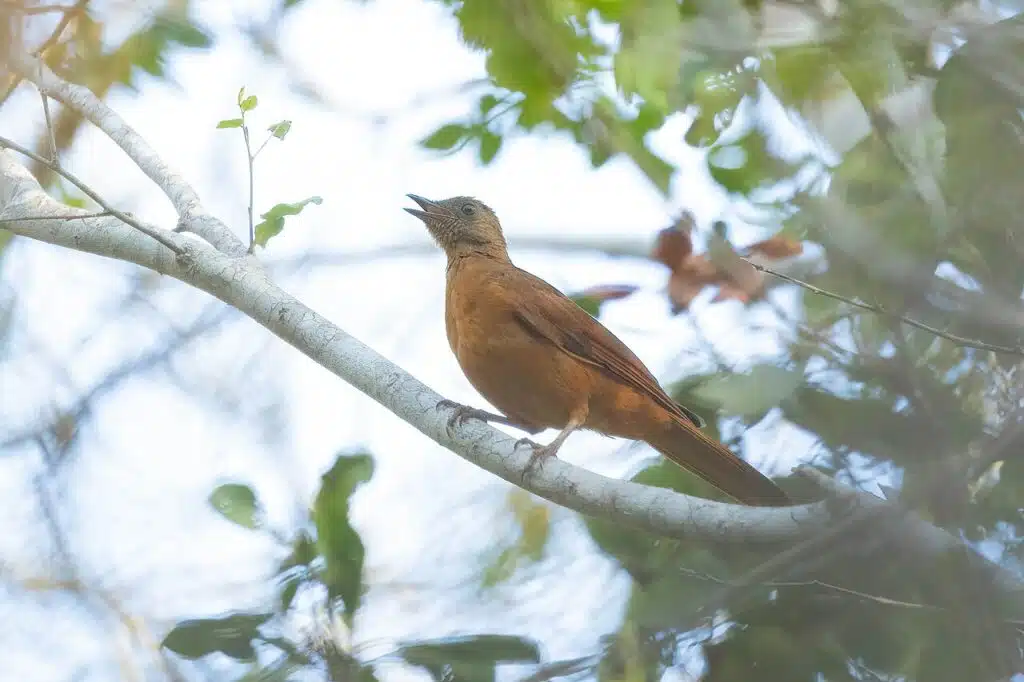
A species of sub-Saharan Africa, Red-Tailed Ant-Thrushes (Neocossyphus rufus) are found in forests across the continent.
These birds live in a large habitat from the Western to the Eastern coast in countries such as Equatorial Guinea, Central African Republic, and Tanzania.
A tendency to live in areas with high ant populations inspires the official name of the species.
While they eat ants, Red-Tailed Ant-Thrushes can also eat other insects.
Much of their coloring is red and brown-red with specific long tails.
Dark red nuances are seen on its upper tail. This is a species that also has orange-red plumage on the underbelly and similar but darker nuances across its wings.
The head has a plain brown appearance, being the only part of its body that isn’t red in some form.
As for its behavior, the bird shows a typical habit of living on the ground or close to the ground, as with other species that feed on ants.
These birds may be perched on lower branches but they always look for ants, sometimes even together.
A flocking tendency is seen with its dispersed populations. These birds use various communication tools such as whistle-like sounds.